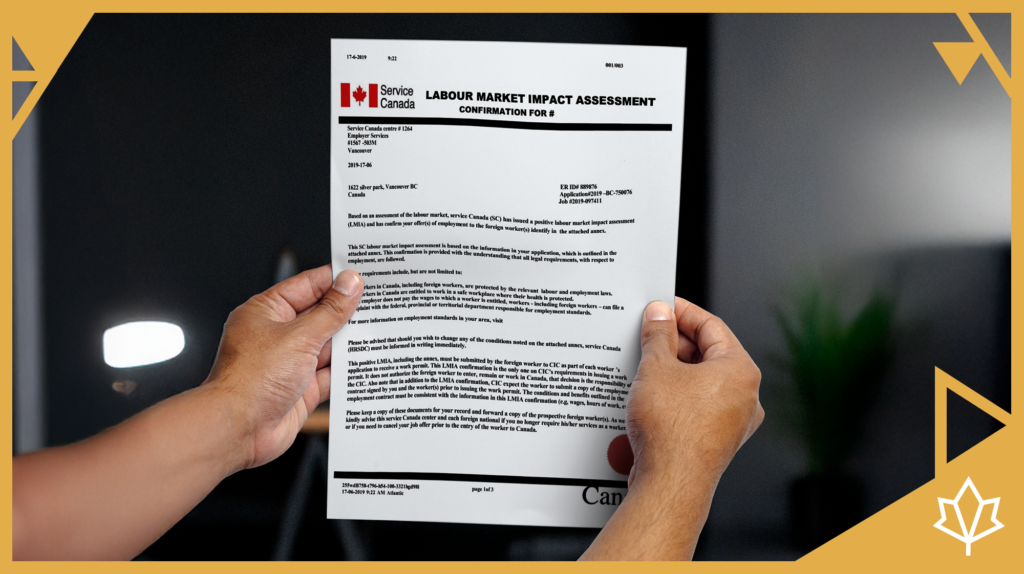Finding qualified skilled workers can be challenging, especially in specialized industries like skilled trades. For Canadian employers who need to recruit internationally, a Labour Market Impact Assessment (LMIA) is, in most cases, an essential first step for the hiring process.
An LMIA is a document issued by Employment and Social Development Canada (ESDC) that verifies the role is not able to be filled locally. Therefore, hiring a foreign worker will not negatively impact the Canadian labour market. In this guide, we’ll cover the steps you need to take to successfully obtain an LMIA and bring qualified workers to work in Canada.
Jump Ahead:
Step 1: Understand the LMIA Requirements
Step 2: Job Advertising and Recruitment Efforts
Step 3: Submit a Complete LMIA Application
Step 4: Pay the LMIA Processing Fee
Step 5: Prepare for an ESDC Interview
Step 6: Await the LMIA Decision
Step 7: Moving forward with an approved or refused LMIA
Step 1: Understand the LMIA Requirements
The LMIA process is designed to ensure that hiring a foreign worker is necessary and that no citizen or permanent resident of Canada is available for the position. To obtain an LMIA, employers must meet several requirements:
- Proof of Recruitment Efforts: Demonstrate that efforts have been made to hire Canadian citizens or permanent residents for the position, meeting the specific advertisement requirements.
- Wages and Working Conditions: Ensure that the wages offered to TFWs are in line with wages paid to Canadian and permanent resident employees hired for the same job and work location, and with similar skills and years of experience..
- Business Legitimacy: Provide documentation proving that your business and job offer are legitimate..

Step 2: Job Advertising and Recruitment Efforts
The first step in the LMIA process, which must be completed before the application is submitted, is demonstrating that you have tried to fill the position with Canadian candidates.
- Job Posting Duration: Typically, the job must be posted on the Government of Canada’s Job Bank, and two or three other job boards, for at least four weeks within three months before submitting the LMIA application.
- Advertisement Requirements: Take note of the specific requirements for your industry and region, as there may be specific requirements or exemptions.
- Documenting Results: Keep records of all applicants, interviews, and reasons for not hiring Canadian candidates.
This documentation proves to ESDC that hiring a foreign worker is a last resort after attempting to recruit domestically.
Step 3: Submit a Complete LMIA Application
Once recruitment efforts are completed, the next step is to submit the LMIA application:
- Required Forms: Complete the appropriate application form online. Be sure to select the correct stream, and depending on the proposed wage, the application will be high-wage or low-wage, each has specific requirements.
- Supporting Documents: Include all necessary documentation, such as proof of recruitment efforts, financial documents demonstrating your business’s stability, and details about the position and its responsibilities.
Double-check that all required information is included to avoid delays in processing.

Step 4: Pay the LMIA Processing Fee
A standard processing fee of $1,000 per position applies to LMIA applications, with some exceptions. For example, employers hiring for in-demand roles in certain programs may be eligible for fee waivers. Review the fee requirements on ESDC’s website to see if any exceptions apply to your situation.
Step 5: Prepare for an ESDC Interview
After submitting the LMIA application, an ESDC officer may contact you to verify the information provided and clarify any questions.
- Review Your Application: Be prepared to answer questions about your recruitment efforts, the job role, and why a Canadian worker could not fill it.
- Be Transparent and Cooperative: Honesty and thoroughness help strengthen your case, showing that the position genuinely needs a foreign worker.
While not all applications will lead to an interview, it is more likely for employers applying for the first time or if there is additional verification required.
Step 6: Await the LMIA Decision
As part of the assessment process, Service Canada will ensure that the employer has met all program requirements. Processing times for LMIAs vary depending on the job location, type of position, and demand for applications. Generally, employers can expect to wait a few weeks to several months for a decision. You can check processing times on the Government of Canada’s official website to estimate when you might receive your results.

Step 7: Moving forward with an approved or refused LMIA
If your LMIA is approved, you can proceed with hiring your international candidate, who will use the positive LMIA to apply for a work permit. If your LMIA is refused, you may address the issues highlighted in the refusal letter and reapply.
Approved LMIA: Your candidate can submit the approved LMIA along with their work permit application, moving one step closer to working in Canada.
Refused LMIA: Review the refusal details carefully, address any gaps or issues, and consider reapplying with stronger evidence or more robust recruitment efforts.
Conclusion
Obtaining an LMIA is a detailed process that requires careful planning and thorough documentation. By understanding the requirements, documenting recruitment efforts accurately, and preparing a complete application, you can significantly improve your chances of a successful LMIA outcome. If you need assistance with the LMIA application process, our team at IVEY Group is here to guide you through compliance and help you find the skilled international talent your business needs to thrive.



